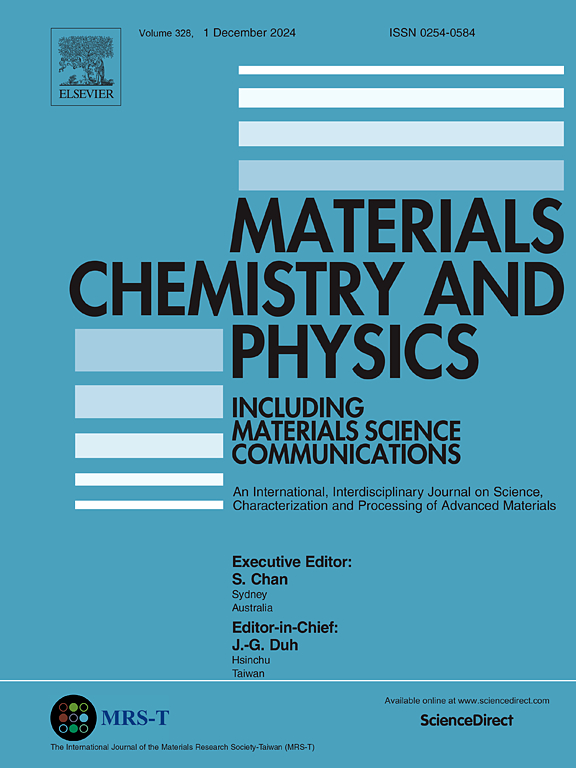Core-mantle-shell framework for optimizing the distribution and size of metallic nanoparticles in dielectric spheres on light absorption and photoelectric efficiency
IF 4.3
3区 材料科学
Q2 MATERIALS SCIENCE, MULTIDISCIPLINARY
引用次数: 0
Abstract
The composite structure of metallic nanoparticles and dielectric spheres, integrating metallic resonances with Mie resonance modes of dielectrics, shows great promise for efficient light absorption applications. However, the spatial distribution and size of metallic nanoparticles within dielectric spheres, aimed at maximizing optical absorption and minimizing photothermal energy loss, remain critical yet underexplored challenges. This work proposes a core–mantle–shell structure that boosts performance by incorporating metallic nanoparticles as a spherical mantle layer positioned in regions of strong electric fields induced by Mie resonances within the dielectric sphere, while enabling a fabrication process that is both straightforward and practical. With optimized spatial distribution and an increased number of nanoparticles, the average visible light absorption at the same Ag volume fraction is boosted to 2.67 times that of a single Ag particle at the sphere's center. The core-mantle-shell structure offers high flexibility in selecting core materials while allowing the shell to be porous. Based on plasmonic hot-electron charge generation and separation model calculations, Ag nanoparticles with a radius of ∼15 nm optimize photoelectric conversion efficiency, achieving 12.55 % under 1.5–3.1 eV light. The optimal metallic nanoparticle positions and sizes in core-mantle-shell structures were also consistent across other metal and dielectric materials, paralleling the results found in the SiO2–Ag NPs-TiO2 core-mantle-shell framework. The optimized structure, synthesized as SiO2–Ag NPs-TiO2 core-mantle-shell, exhibited significantly enhanced light absorption in the visible range. Compared with the SiO2–TiO2 core-shell, the photocatalytic degradation rate of methyl orange was improved by a factor of 4.5.

基于光吸收和光电效率的核-幔-壳结构优化金属纳米颗粒在介质球中的分布和尺寸
金属纳米颗粒和介电球的复合结构,将金属共振与介电体的Mie共振模式相结合,在高效光吸收应用中具有广阔的前景。然而,金属纳米颗粒在介质球内的空间分布和尺寸,旨在最大化光吸收和最小化光热能量损失,仍然是关键但尚未被探索的挑战。这项工作提出了一种核心-地幔-壳结构,通过将金属纳米颗粒作为球形地幔层结合在电介质球内由Mie共振引起的强电场区域中,从而提高了性能,同时使制造过程既简单又实用。随着空间分布的优化和纳米粒子数量的增加,相同Ag体积分数下的平均可见光吸收率提高到球体中心单个Ag粒子的2.67倍。芯-幔-壳结构在选择芯材料方面提供了很高的灵活性,同时允许壳具有多孔性。基于等离子体热电子电荷产生和分离模型计算,半径为~ 15 nm的Ag纳米粒子优化了光电转换效率,在1.5-3.1 eV光下达到12.55%。在其他金属和介质材料中,核-幔-壳结构中的最佳金属纳米颗粒位置和尺寸也一致,与SiO2-Ag NPs-TiO2核-幔-壳结构中的结果相似。优化后的结构为SiO2-Ag NPs-TiO2核-幔-壳,在可见光范围内的光吸收显著增强。与SiO2-TiO2核壳材料相比,甲基橙的光催化降解率提高了4.5倍。
本文章由计算机程序翻译,如有差异,请以英文原文为准。
求助全文
约1分钟内获得全文
求助全文
来源期刊

Materials Chemistry and Physics
工程技术-材料科学:综合
CiteScore
8.70
自引率
4.30%
发文量
1515
审稿时长
69 days
期刊介绍:
Materials Chemistry and Physics is devoted to short communications, full-length research papers and feature articles on interrelationships among structure, properties, processing and performance of materials. The Editors welcome manuscripts on thin films, surface and interface science, materials degradation and reliability, metallurgy, semiconductors and optoelectronic materials, fine ceramics, magnetics, superconductors, specialty polymers, nano-materials and composite materials.
 求助内容:
求助内容: 应助结果提醒方式:
应助结果提醒方式:


